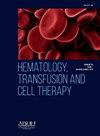直肠癌恶病质患者的脂肪组织代谢
IF 1.6
Q3 HEMATOLOGY
引用次数: 0
摘要
通过氟脱氧葡萄糖F-18 (FDG)正电子发射断层扫描/计算机断层扫描(PET/CT)评估的脂肪组织(AT)葡萄糖摄取反映了组织代谢活动,并可能与脂肪细胞和炎症细胞活性的葡萄糖代谢有关。此外,通过计算机断层扫描(CT)测量的脂肪组织放射密度已成为一种有前途的代谢生物标志物。增加的AT放射密度可能表明炎症或棕色脂肪组织(BAT)的存在,为癌症恶病质背后的病理生理过程提供了见解。目的通过¹⁸F-FDG PET/CT分析和CT评估恶病质(C)和非恶病质(NC)直肠癌患者内脏脂肪组织(VAT)和皮下脂肪组织(SAT)的葡萄糖摄取,评估其脂肪组织代谢。材料和方法本研究是一项横断面研究,涉及确诊为直肠癌的患者。恶病质是根据Fearon的标准进行分类的,定义为体重减轻超过5%,或者体重减轻超过2%,根据目前的体重和身高(身体质量指数[BMI] <;20 kg/m2)或骨骼肌质量低(根据马丁标准定义)。基于Hounsfield Units (HU)组织测量的差异,使用经SliceOmatic软件处理的计算机断层扫描(CT)图像分析身体成分和组织放射密度。PET/CT图像的分割和数据采集在斐济进行,Beth Israel插件用于斐济。在分割区域(VAT和SAT),收集葡萄糖摄取值(¹⁸F-FDG),用标准摄取值(SUV)变量表示。采用正糖高胰岛素钳测定m值。从医疗记录中收集人口统计学特征、疾病相关数据和生化测试结果。使用Jamovi®2.3版进行统计分析。本研究方案已获机构审查委员会批准(CAAE: 91217418.2.0000.5404)。结果共纳入36例患者。诊断恶病质25例(69.4%)。C组中位年龄为64岁(范围:43-74),NC组中位年龄为62岁(范围:47-72)。所有C组患者体重减轻超过5%,其中36.4%的患者肌肉不足。恶病质患者的VAT SUV平均值(0.815±0.184)高于非恶病质患者(0.644±0.148),p = 0.005。VAT葡萄糖摄取与VAT放射密度相关(rho = 0.678,p <;0.001)与减重(rho = 0.434,p = 0.015)呈负相关(rho = -0.412,p = 0.021)。此外,增值税radiodensity与增值税面积呈负相关(ρ = -0.452,p = 0.008),坐在区域(ρ = -0.465,p = 0.006),和BMI(ρ = -0.695,p = 0.015)。VAT辐射密度与SAT辐射密度呈正相关(rho = 0.633,p <;0.001)和SAT SUV平均值(rho = 0.532,p = 0.002)。增值税SUV均值与m值无显著相关;然而,m值tbw与VAT辐射密度相关(rho = 0.369,p = 0.03)。结论VAT代谢可能作为恶病质的潜在生物标志物,并强调有必要扩大对影响恶病质病理生理的代谢改变的研究。本文章由计算机程序翻译,如有差异,请以英文原文为准。
ADIPOSE TISSUE METABOLISM IN RECTAL CANCER PATIENTS WITH CACHEXIA
Introduction/Justification
Adipose tissue (AT) glucose uptake, assessed by Fludeoxyglucose F-18 (FDG) positron emission tomography/computed tomography (PET/CT), reflects tissue metabolic activity and may be linked to both glucose metabolism by adipocytes and inflammatory cell activity. Additionally, adipose tissue radiodensity, measured by computed tomography (CT), has emerged as a promising metabolic biomarker. Increased AT radiodensity may indicate inflammation or the presence of brown adipose tissue (BAT), providing insights into pathophysiological processes underlying cancer cachexia.
Objectives
The purpose of this study was to evaluate adipose tissue metabolism, assessed by the visceral adipose tissue (VAT) and subcutaneous adipose tissue (SAT) glucose uptake through ¹⁸F-FDG PET/CT analysis and VAT and SAT radiodensity assessed by CT in cachexia (C) and non-cachexia (NC) rectal cancer patients.
Materials and Methods
This is a cross-sectional study involving patients diagnosed with rectal cancer. Cachexia was categorized according to Fearon's criteria, being defined as weight loss greater than 5%, or weight loss greater than 2% in individuals already showing depletion according to current bodyweight and height (body-mass index [BMI] < 20 kg/m2) or low skeletal muscle mass (defined according to Martin's criteria). Body composition and tissue radiodensity was analyzed using computed tomography (CT) images processed with the SliceOmatic software based on the difference in tissue measurements by Hounsfield Units (HU). The segmentation and data collection of PET/CT images are performed in FIJI and the Beth Israel Plugin for FIJI. In the segmented areas (VAT and SAT), glucose uptake values (¹⁸F-FDG) are collected, represented by the Standard Uptake Value (SUV) variable. M-value was determined using euglycemic hyperinsulinemic clamp. Demographics characteristics, disease-related data, and biochemical test results were collected from medical records. Statistical analyses were performed using Jamovi® version 2.3. This study protocol was approved by the Institutional Review Board (CAAE: 91217418.2.0000.5404).
Results
A total of 36 patients were included in the analysis. Cachexia was diagnosed in 25 patients (69.4%). The median age was 64 years (range: 43-74) in the C group and 62 years (range: 47-72) in the NC group. Weight loss greater than 5% occurred in all C patients, and low muscularity in 36.4% of this group. Cachexia patients had a higher VAT SUV mean (0.815 ± 0.184) compared to NC (0.644 ± 0.148), p = 0.005. VAT glucose uptake was correlated with VAT radiodensity (rho = 0.678, p < 0.001) and weight loss (rho = 0.434, p = 0.015) while it was negatively correlated with VAT area (rho = -0.412, p = 0.021). Additionally, VAT radiodensity showed a negative correlation with VAT area (rho = -0.452, p = 0.008), SAT area (rho = -0.465, p = 0.006), and BMI (rho = -0.695, p = 0.015). Positive correlations were observed between VAT radiodensity and SAT radiodensity (rho = 0.633, p < 0.001) and SAT SUV mean (rho = 0.532, p = 0.002). No significant correlation was found between VAT SUV mean and M-value; however, M-value-TBW correlated with VAT radiodensity (rho = 0.369, p = 0.03).
Conclusion
These findings suggest that VAT metabolism may serve as a potential biomarker in cachexia and underscore the need to expand investigations into the metabolic alterations that influence the pathophysiology of cachexia.
求助全文
通过发布文献求助,成功后即可免费获取论文全文。
去求助
来源期刊

Hematology, Transfusion and Cell Therapy
Multiple-
CiteScore
2.40
自引率
4.80%
发文量
1419
审稿时长
30 weeks
 求助内容:
求助内容: 应助结果提醒方式:
应助结果提醒方式:


